Library
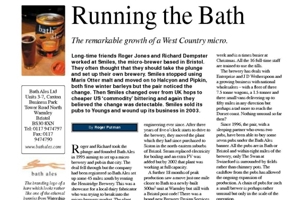 IBD Membership Required
IBD Membership Required
Running the Bath
By: Roger Putman
01/05/2007
Long-time friends Roger Jones and Richard Dempster worked at Smiles, the micro-brewer based in Bristol. They often thought that they should take the plunge and set up their own brewery. Smiles stopped using Maris Otter malt and moved on to Halcyon and Pipkin, both fine winter barleys but the pair noticed the change. Then Smiles changed over from UK hops to cheaper US ‘commodity’ bittering and again they believed the change was detectable. Smiles sold its pubs to Youngs and wound up its business in 2003.
 IBD Membership Required
IBD Membership Required
What news upon the Rialto?
By: Mark Eaton-Park
01/05/2007
Isn’t it funny how you remember the odd line of Shakespeare drummed into you almost fifty years ago? Our title comes from the Merchant of Venice although the immortal line “You that did void your rheum upon my beard” appealed more to a pubescent teenager! Tucked up at the top of the Adriatic, Venice was a great trading city; the city of Marco Polo, staging point for the Crusades. Trade brought great wealth and it was the home of Titian, Tintoretto and Bellini whose works adorned the palaces of the rich merchants about whom Shakespeare wrote in 1597.
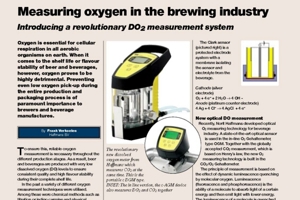 IBD Membership Required
IBD Membership Required
Measuring oxygen in the brewing industry
By: Frank Verkoelen
01/05/2007
Oxygen is essential for cellular respiration in all aerobic organisms on earth. When it comes to the shelf life or flavour stability of beer and beverages, however, oxygen proves to be highly detrimental. Preventing even low oxygen pick-up during the entire production and packaging process is of paramount importance to brewers and beverage manufactures.
 IBD Membership Required
IBD Membership Required
A Smart move
By: Roger Putman
01/05/2007
One of the underpinning ‘philosophies’ of Nottingham University’s Food Science Department is to ‘discover and apply fundamental knowledge from farm to fork’ They may wish to review that statement in the light of the appointment of Dr Katherine Smart as the new SABMiller Professor of Brewing Science. The new department is situated on the leafy Sutton Bonington campus which is some way south of the city and indeed closer to the equally prestigious University of Loughborough.
 IBD Membership Required
IBD Membership Required
The three-tier US beer supply chain
By: Roger Putman
01/05/2007
Whilst in San Antonio to meet with Carlos Alvarez at Gambrinus, I visited the Blue Star brewpub. There were seven beers on tap including a hand-pumped firkin sitting on the bar. All the beers were of a good standard and we inspected top-end bicycles which proprietor Joey Villareal assembles as a side-line. 33-year old Joey also runs a chain of five other bars, the latest due to open that very night was just the other side of the brewpub car park. I remarked on the lack of hand pulls and was informed that he is not allowed to service his own bar from his own pub just fifty yards away.
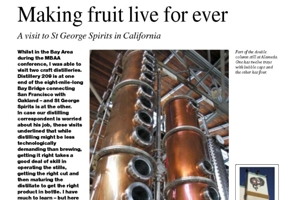 IBD Membership Required
IBD Membership Required
Making fruit live for ever
By: Roger Putman
01/05/2007
Whilst in the Bay Area during the MBAA conference, I was able to visit two craft distilleries. Distillery 209 is at one end of the eight-mile-long Bay Bridge connecting San Francisco with Oakland – and St George Spirits is at the other. In case our distilling correspondent is worried about his job, these visits underlined that while distilling might be less technologically demanding than brewing, getting it right takes a good deal of skill in operating the stills, getting the right cut and then maturing the distillate to get the right product in bottle. I have much to learn – but here goes!
 IBD Membership Required
IBD Membership Required
Beer in Japan – present and future trends
By: Kazuo Natakani
01/05/2007
How the imbalance of alcohol duties imposed by Japan’s government was challenged by innovative brewing techniques.
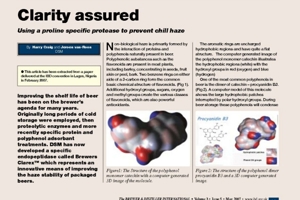 IBD Membership Required
IBD Membership Required
Clarity assured
By: Harry Craig, Jeroen van-Roon
01/05/2007
Improving the shelf life of beer has been on the brewer’s agenda for many years. Originally long periods of cold storage were employed, then proteolytic enzymes and more recently specific protein and polyphenol adsorbant treatments. DSM has now developed a specific endopeptidase called Brewers Clarex™ which represents an innovative means of improving the haze stability of packaged beers.
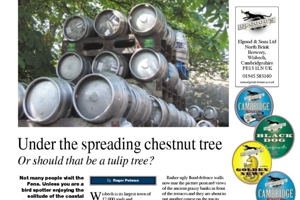 IBD Membership Required
IBD Membership Required
Under the spreading chestnut tree
By: Roger Putman
01/05/2007
Not many people visit the Fens. Unless you are a bird spotter enjoying the solitude of the coastal flats, stop off to visit the odd butterfly farm or are simply lost, this vast flat expanse is unknown to most Brits. Barely above sea level and crisscrossed with man-made water courses under huge skies, Fenland remains the province of the few folk who live there.
 IBD Membership Required
IBD Membership Required
Refrigeration project demonstrates excellent savings
By: Andy Tighe
01/05/2007
A major investigation funded by the Carbon Trust and supported by the British Beer & Pub Association (BBPA) into refrigeration system efficiency in food and drink manufacturing has shown potential energy savings of up to 40%. The high price of electricity and the growing importance of CO2 emission reductions under Climate Change policies make it doubly important that users try to benefit from the excellent energy saving potential.
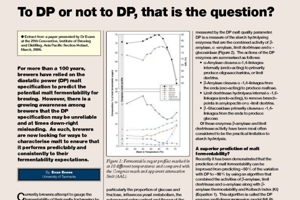 IBD Membership Required
IBD Membership Required
To DP or not to DP, that is the question?
By: Evan Evans
01/05/2007
For more than a 100 years, brewers have relied on the diastatic power (DP) malt specification to predict the potential malt fermentability for brewing. However, there is a growing awareness among brewers that the DP specification may be unreliable and at times down-right misleading. As such, brewers are now looking for ways to characterise malt to ensure that it performs predictably and consistently to their fermentability expectations.
 IBD Membership Required
IBD Membership Required
Control valve sizing – a balancing act
By: Rick Plummer
01/05/2007
It may seem a straightforward procedure, but correctly sizing control valves for steam systems holds many potential pitfalls for the inexperienced. Whether they’re used for simple heating control or as part of a sophisticated process control system, steam control valves must be accurately specified not only to ensure the most accurate and reliable control possible, but also to help avoid noise and erosion.
 IBD Membership Required
IBD Membership Required
Buckwheat beers help coeliacs
By: Hilde Wijngaard, Elke Arendt
01/05/2007
Coeliac disease is an autoimmune condition, triggered by the ingestion of gluten. The symptoms (diarrhoea, skin disorders, depression, osteoporosis, fatigue, anaemia and weight loss) are diverse and can mimic other diseases. Due to enhanced screening techniques and higher awareness, the incidence of coeliac disease is higher than previously thought but also more easily detected. New screening results revealed that for example the incidence of coeliac disease in the UK is 1 in 112 (Table 1). Ireland shows an even higher incidence of the disease at 1 in 80.
 IBD Membership Required
IBD Membership Required
Food...not waste
By: Michael Parsons
01/05/2007
In times past, the activity of James & Son could be simply summarised: control the lorry movements so that the brewery spent grain silos do not overflow, at the same time make sure that the farmers do not run out of feed. Get the balance right, there will be some happy ruminants in the field – and a profit.
 IBD Membership Required
IBD Membership Required
All barleys are born equal
By: Rupert Ponsonby
01/05/2007
In early 2006, Robin Appel – specialist maltster and saviour of the Maris Otter race – decided it was time to act. He was certain in his heart of hearts that all barleys were not born equal, and that his passion for Maris Otter was with reason; but was his passion justified? Where was the empirical evidence? Where was the proof? Wasn’t it about time that barley as a category began to extract itself from commoditised pricing?
Some of the content requires an active membership to view.
You can find out more here
Some of the content requires an active membership to view.
You can find out more here
